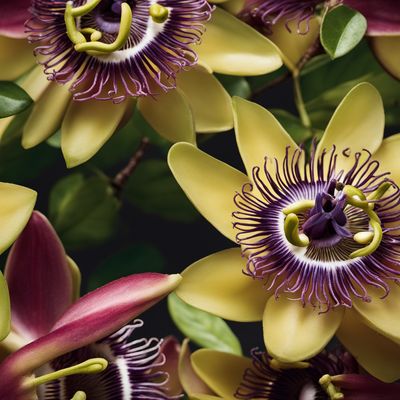
Ingredient
Passionfruits and similar-
The Tropical Treasure
Passionfruits, along with their close relatives like maracuja and granadilla, are small round fruits with a vibrant purple or yellow skin. Inside, they contain a jelly-like pulp filled with small black seeds. The flavor of passionfruit is a delightful combination of sweet and tart, with tropical notes reminiscent of pineapple and citrus. The texture of the pulp is soft and slightly grainy, providing a unique mouthfeel.
Origins and history
Passionfruits are native to South America, particularly Brazil and Paraguay, where they have been cultivated for centuries. They were later introduced to other tropical regions around the world, including Southeast Asia, Australia, and Africa. Passionfruits have a rich cultural significance in South America, where they are used in traditional desserts, beverages, and even as a natural remedy for various ailments.
Nutritional information
Passionfruits are a good source of vitamin C, dietary fiber, and antioxidants. They are also low in calories, with approximately 17 calories per fruit. The seeds of passionfruits are rich in healthy fats and provide a small amount of protein.
Allergens
Passionfruits and similar fruits may cause allergic reactions in some individuals, particularly those with a history of fruit allergies. It is recommended to consume them in moderation and consult with a healthcare professional if you have any concerns or known allergies.
How to select
When selecting passionfruits and similar fruits, look for fruits that are heavy for their size and have a slightly wrinkled skin. This indicates ripeness and ensures that the fruit is juicy and flavorful. Avoid fruits with blemishes, mold, or signs of decay. For passionfruits, choose fruits with a deep purple or yellow skin, depending on the variety.
Storage recommendations
To prolong the shelf life of passionfruits and similar fruits, store them at room temperature until they are fully ripe. Once ripe, refrigerate them to slow down the ripening process and extend their freshness. It is best to consume passionfruits within a week of purchase or harvest to enjoy their optimal flavor and texture.
How to produce
Passionfruit vines can be grown in tropical and subtropical regions with warm temperatures and well-drained soil. They require a trellis or support structure to climb on and prefer full sun or partial shade. Passionfruits are typically propagated from seeds or cuttings, and they can take up to a year to bear fruit. Regular pruning and fertilization are necessary to maintain healthy growth and fruit production.
Preparation tips
Passionfruits and similar fruits can be used in a variety of culinary applications. They are commonly used in desserts like mousses, tarts, and cakes, where their tangy flavor adds a refreshing contrast to sweet ingredients. Passionfruit pulp can also be used to make sauces, syrups, and cocktails. Additionally, the seeds can be sprinkled over salads, yogurt, or ice cream for added texture and flavor.
Culinary uses
Passionfruits and similar fruits are widely used in tropical and subtropical cuisines around the world. They are a key ingredient in popular desserts like passionfruit mousse in Brazil, passionfruit pavlova in Australia, and passionfruit sorbet in Southeast Asia. These fruits are also used in beverages, such as passionfruit juice and cocktails. Additionally, passionfruits are increasingly incorporated into fusion cuisines, where their unique flavor profile adds an exotic twist to traditional dishes.
Availability
Passionfruits and similar fruits are commonly available in tropical and subtropical regions, including South America, Southeast Asia, Australia, and Africa. They can also be found in specialty stores or imported from these regions in other parts of the world.
More ingredients from this category

Monstera fruits
The Exotic Delight

Giant granadillas
The Exotic Marvel: Exploring the World of Giant Granadillas

Wingedstem passionflower fruits
The Exotic Delights of Wingedstem Passionflower Fruits

Passionfruits
The Exotic Delight: Passionfruits

Granadillas
The Tropical Treasure: Granadillas

Banana passionfruits
The Tropical Delight